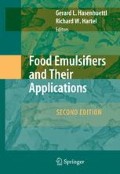The application margarine and spreads refers to a series of products, which are likened to butter, but have different fat contents. The definition of margarine is rigidly fixed with regards to fat content, a minimum of 80% by weight must be present, but the rheological characteristics of margarine can range from liquid to plastic in nature. Any edible oil or fat source may be used in its manufacture.
The definition of spreads is more ambiguous since they may contain a wide variety of fat contents, thus promoting the low fat, and reduced fat spread concept. This typically refers to anything between 25 and 70% fat content, but today modern demands often exist for even lower fat levels.
Margarine was invented in response to a request from the French Government of Napoleon III for a less expensive, longer life replacement for butter. The invention, credited to Hippolyte Mège-Mouriez, took place around 1860s and focussed on the rendering of tallow fat by artificial gastric juices, a crystallisation step at ambient temperature and extraction under pressure to obtain oleomargarine, a semi-fluid fraction and oleostearine, a hard white fat in the ratio of 60:40 respectively. The softer fraction was noted to have a flavour not dissimilar to butter fat, a similar melting point and a typical pale yellow colour, and the material could easily be plasticised. Thus, it represented a firm foundation material for the production of a butter substitute. The material was thought to contain glycerides of margaric acid, but it is now established that the fatty acid content is made up from palmitic and stearic acids—but nonetheless the name margarine has stuck.
Access this chapter
Tax calculation will be finalised at checkout
Purchases are for personal use only
Preview
Unable to display preview. Download preview PDF.
References
Berger, K.G., and Idris, N.A. (2005). Formulation of zero-trans acid shortenings and margarines and other food fats with products of the oil palm, J. Am. Oil Chem. Soc. 82: 775–782.
Bot, A., Flöter, E., Lammers, J.G., and Pelan, E. (2003). Controlling the texture of spreads. in Texture in Foods Vol.1. Ed. McKenna, B.M. pp 350–372.
Britannia Food Ingredients Ltd. (2000). http://www.britanniafood.com.
Chrysam, M.M. (1996) Margarines and spreads. in Bailey’s Industrial Oil and Fat Products, 5th Edition. Vol. 3 Edible Oil and Fat Products and Application Technology. Ed. Hui, Y.H. pp 65–114.
Delamarre, S., and Batt C.A. (1999). Food Microbiol. 16, 327–333.
Flack, E. (1997). Margarines and spreads. in Food Emulsifiers and Their Applications. Eds. Hasenhuettl, G.L., and Hartel, R.W. pp 270–274.
Hernqvist, L. (1988). Fat Science Technology, pp 451–454.
Hoerr, C.W. (1960). Morphology of fats, oils shortening, J. Am. Oil Chem. Soc. 37: 539–546.
Klemann L., (2004). Kraft Foods Inc., INFORM, April, 231.
Madsen, J. (2003). Fat Crystallography—A Review. Technical Paper TP 1504–2e, Dansico A/S.
Madsen, J., and Als, G. (1968). Sandiness in table margarine and the influence of various blends of tri-glycerides and emulsifiers thereof. ISF. Rotterdam, pp 11–17.
Marangoni, A.G. (2005). Fat Crystal Networks. Marcel Dekker, New York.
O’Brien, R D. (1998). Fats & Oils: Formulating and Processing for Applications, Technomic, Lancaster, P.A. p 361.
Siew, W L., (2002). Understanding the interactions of diacylglycerols with oils for better product performance, Palm Oil Dev. (MPOB) 36: 6–12.
Tamstorf, S., Jønsson, T., and Krog, N (1986). The role of fats and emulsifiers. in Baked Products: Chemistry and physics of Baking Materials, Processes and Products, ed. J.M.V. Blanshard. London: RSC, 75–88.
Timms, R. (1991). Crystallisation of Fats, Chemistry & Industry (SCI), May 20th, 342–344.
van Soest, T.C., de Jong, S., and Roijers, E.C. (1990). J. Am. Oil Chem. Soc. vol 67, pp 415.
Wassell, P. (2005). Low trans shortenings 96th AOCS Annual Meeting + EXPO, 1–4th May 2005, Salt Lake City, Utah, USA.
Wassell, P., and Young, N.W.G. (2007). Food Applications of trans fatty acid substitues. International Journal of Food Science and Technology 42 (5): 503–517.
Yap, P.H., deMan, J. M., and deMan, L. (1989). Polymorphic stability of hydrogenated canola oil as affected by addition of palm oil, J. Am. Oil Chem. Soc. 66 (12): 1784–1791.
Author information
Authors and Affiliations
Editor information
Editors and Affiliations
Rights and permissions
Copyright information
© 2008 Springer Science+Business Media, LLC
About this chapter
Cite this chapter
Young, N., Wassell, P. (2008). Margarines and Spreads. In: Hasenhuettl, G.L., Hartel, R.W. (eds) Food Emulsifiers and Their Applications. Springer, New York, NY. https://doi.org/10.1007/978-0-387-75284-6_11
Download citation
DOI: https://doi.org/10.1007/978-0-387-75284-6_11
Publisher Name: Springer, New York, NY
Print ISBN: 978-0-387-75283-9
Online ISBN: 978-0-387-75284-6
eBook Packages: Chemistry and Materials ScienceChemistry and Material Science (R0)

